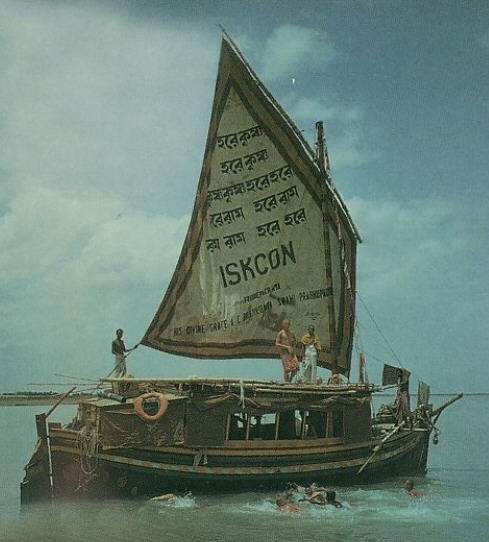
Pilgrims sail the Ganges to visit holy places
of Lord Caitanya and His associates.
I WAS LIVING IN Mayapur in 1976 when Srila Prabhupada inaugurated a boat the Nitai Pada Kamala on which devotees would travel the Ganges (Ganga) to bring Krsna consciousness to Bengal villages. Though I yearned to join the tour, the boat had no quarters for women.
Now, twenty-two years later, I'm again living in Mayapur. One day Jayapataka Swami, one of the leaders here, announces that he and a group of devotees are about to depart on a "Ganga Safari," stopping at many holy places, * (The holy places mentioned in this article are all connected with eternally liberated associates of Lord Caitanya. Readers interested in learning more about these devotees should consult the Sri Caitanya-caritamrta) some inaccessible by road but easily reached on the Ganga. The same Deities of Lord Caitanya and Lord Nityananda who traveled on the Nitai Pada Kamala will be onboard one of the three boats. Women and children are invited.
March 21, 1998
My thirteen-year-old son, two of his friends, and I depart by bus for Calcutta with about sixty other devotees from around the world. At Calcutta's Howrah Station we catch an overnight train north to the state of Bihar.
March 22
In the middle of the night the train stops at Burdwan station, where Jayapataka Swami and ten devotees jump on. At 7:00 A.M. we reach a tiny railroad station, Tala Jhari. We pile into waiting vans and small buses and drive a short distance to our first designation, Kanai Natshala.
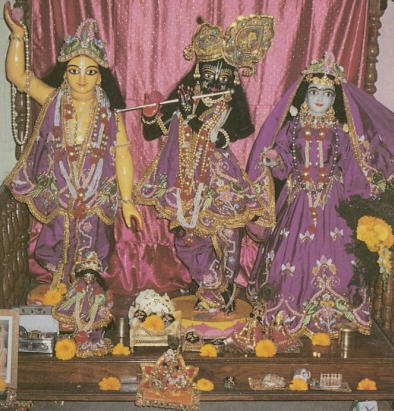
We chant and dance our way into the strikingly clean village, nestled in a forest of mango trees. High on a hill overlooking the Ganga is an ancient temple recently donated to ISKCON. The former pujari (priest), Narasimha Baba, was a Vaisnava in the Ramanuja sampradaya (disciplic succession) who had dedicated his life to serving the Radha-Krsna Deities in the temple. More than three hundred years ago, the former owners of the temple had handed it over to the Ramanuja sampradaya with the stipulation that if the Ramanujas were ever unable to protect the Deities, the worship should be turned over to the preeminent branch of Lord Caitanya's sampradaya. Unfortunately, a few years ago the Deities were stolen. To uphold the original agreement and assure the protection of the new Deities, Narasimha Baba turned the temple over to ISKCON, which he considered the foremost movement in carrying on Lord Caitanya's mission.
Jayapataka Swami tells us the story from the Sri Caitanya-caritamrta of Nrsimha Brahmacari, who meditated on making a beautiful jeweled road for Lord Caitanya to walk to Vrndavana. When in his meditation Nrsimha Brahmacari came to Kanai Natshala, he couldn't go any farther and concluded that Lord Caitanya wouldn't go to Vrndavana. Later Lord Caitanya was walking to Vrndavana when he arrived at Kanai Natshala, followed by a large crowd of people. He announced that Kanai Natshala was a hidden (gupta) Vrndavana and decided it was the wrong time to go to Vrndavana after all. He didn't go any farther than Kanai Natshala, just as Nrsimha Brahmacari had predicted.
Jayapataka Swami also explained that in the Caitanya Bhagavata, Kanai Natshala is described as the place where Lord Caitanya first realized Krsna and experienced pure love of Krsna in separation (viraha).
March 23
During the morning class, Jayapataka Swami explains that for Lord Krsna the cows are special and for Lord Caitanya the Ganga is special. Lord Caitanya said that the Ganga is liquid krsna–prema love for Krsna. Lord Caitanya bathed daily in the Ganga, and when He left this world, Ganga Devi, the deity of the river, felt great separation. Therefore we should remember Lord Caitanya when we bathe in the Ganga. And we should chant Hare Krsna while we bathe, because Lord Caitanya promised Ganga that devotees would come and chant while bathing in her water.
March 24
This morning we all travel in one boat in the rain and then take a bus to Ramakeli. We go to a peaceful temple, the home of Rupa Gosvami and Sanatana Gosvami. We tour several holy places connected with Rupa and Sanatana, including the prison where the Shah had Sanatana Gosvami locked up. My favorite place is a huge cylindrical tower that Sanatana Gosvami designed. We ascend it by an interior circular staircase. Because of the brilliance of the design, the Shah made Sanatana Gosvami his prime minister. The Shah didn't want to risk having such a genius working against him. The tower was completed in 1486, the year of Lord Caitanya's birth.
In the evening we take a bus to Ziya Ganj, arriving about midnight. There are supposed to be three boats to take us across the river to our guest house, but there's only one. Carrying our luggage, we all pack in. After four hours of sitting on the boat waiting for our accommodations to be worked out, we check into our rooms.
March 25
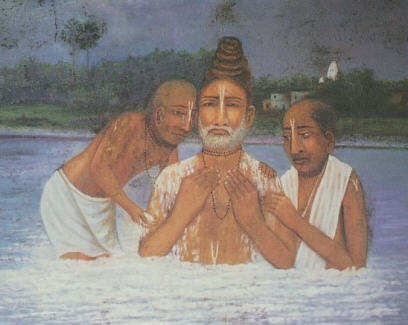
Srila Narottama Dasa Thakura
This morning we walk to Narottama Dasa Thakura's temple, where we offer respects to Narottama's Radha-Krsna Deities and his self-manifested Deity of Lord Caitanya and the Radha-Krsna Deities of Ganga Narayana Cakravarti, Narottama's disciple.
I am amazed to hear the story of Narottama Dasa Thakura's passing. He was bathing in the Ganga nearby when, by his own will, his body melted and became milk. His disciples quickly caught up some of the milk in pots, which are enshrined in hissamadhi, or sacred tomb.
After Narottama's passing, the Deities were worshiped by his disciple Ganga Narayana Cakravarti, who later brought the king of Manipur to Krsna consciousness. Since then Manipur has been a predominantly Vaisnava state.
In the late afternoon we made our maiden voyage in the three boats, chanting Hare Krsna as we passed by waving villagers. We saw the one-thousand-door palace of Sriraj Dulah, the last Moghul emperor before the British Raj. That night we docked at Berhampore Town and we're received by hundreds of local devotees.
March 26
We travel by boat to Uddharampur to visit the shrine of Uddharana Datta Thakura, a great disciple of Lord Nityananda. It's evening when we arrive, and there are no lights in the compound, but we chant and dance jubilantly, surrounded by hundreds of villagers.
Uddharana Datta Thakura established a temple here. When he passed away, a king took the Deities to his palace to worship Them. Once a year the Deities return here for a festival.
Lord Nityananda Prabhu came here often. His daughter, Ganga Gosvamini, lived nearby with her husband. Krsnadasa Kaviraja Gosvami, the author of Sri Caitaya-caritamrta, also lived nearby.
In the compound are two large trees. Lord Nityananda held a kirtana under one of them. As for the other tree, one day Lord Nityananda brushed his teeth here with a neem twig. When He stuck the twig into the ground, a neem tree sprouted.
March 27
We travel a short distance to the city of Katwa, where Lord Caitanya accepted sannyasa, the renounced order of life. We chant as we walk to the asrama of Kesava Bharati, Lord Caitanya's sannyasa-guru. The asrama is now a temple with a large Deity of Lord Caitanya.
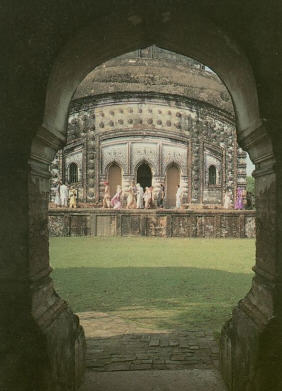
Lord Caitanya came here and sat under the tree with a few devotees. Caitanya Dasa, Srinivasa Acarya's father, was on his way to see Lord Caitanya when he came to Katwa and heard that the Lord was there. Later he wrote a first-hand account of this pastime. He describes that Lord Nityananda, Gadadhara, Mukunda, and others were present. Caitanya Dasa maneuvered to get in the front row to see Lord Caitanya dancing and chanting in intense kirtana. Tears were pouring from the Lord's eyes as if from a syringe, and people were getting wet from the tears.
Then Lord Caitanya stopped the kirtana and said, "It's time to cut My hair."
Fearing their impending separation from the Lord, everyone protested, and the barber refused to cut the Lord's hair.
Lord Caitanya told him, "This is your duty; you must do it."
Finally the barber did it, and Lord Caitanya danced in great ecstasy and embraced Kesava Bharati. The barber became so full of bliss that he could only chant the names of the Lord. He never cut hair again.
We all touch the tree under which Lord Caitanya sat. Next to the tree we admire a painting of the hair-cutting scene, depicting Lord Caitanya with a newly shaved head, surrounded by extremely distressed devotees. The barber is at the Lord's feet, crying in bliss while lying on the cut hair. Near the entrance we view the Kesha Samadhi, which holds Lord Caitanya's hair, as well as the samadhi of Gadadhara Dasa, who established the Deity worship here.
We walk to a courtyard beside the temple to honor Kesava Bharati's samadhi, the barber's samadhi, and a small temple holding the footprints of Lord Caitanya and Kesava Bharati.
A bus takes us out of the city to a village named Srikhanda, the birthplace of Narahari Sarakara. In a song by Srila Bhaktivinoda Thakura, Narahari is depicted as standing to Lord Caitanya's right, fanning Him with a camara fan.
Narahari's brother Mukunda had a son named Raghunandana who was an associate of Lord Caitanya. As a young boy Raghunandana became famous for insisting that his family's household Deity eat the food He was offered. When the boy's father watched to see what was happening, he saw the stone Krsna Deity eating a laddu (a round sweet) from his son's hand.
Hearing the glories of Raghunandana, a devotee named Abhirama Ramadasa wanted to meet him. Abhirama traveled some distance to meet the boy. They were so happy to meet each other that they embraced and danced. Raghunandana danced so intensely that his ankle bells fell off and flew two kilometers away.
We visit a few other holy places in Srikhanda. In one temple we touch the seat where Narahari Sarakara, a year after he'd passed away, reappeared during a festival. Everyone present could see him.
After driving a distance away, we dance and roll in the dust where Raghunandana and Abhirama Ramadasa danced together.
On our return to Katwa, we stop at the village of Chakundi Jajigram to visit Srinivasa Acarya's home, where his Deities of Radha-Madana-Mohana are located.
Jahnava Devi, Lord Nityananda's wife, came here and wanted to prepare a feast for all the devotees. But there was no place big enough for keeping the dal (split beans). So the devotees dug a pond, and filled it with dal. Now the pond is filled with water. We offer our respects to this sacred pond.
March 28
We visit the birthplace of Srinivasa Acarya at Chakundi and offer our respects to his Deities.
Further down the Ganga we stop at Agradvipa and visit the Radha-Krsna temple of Govinda Ghosa, another associate of Lord Caitanya.
March 29
After a brief halt at ISKCON Mayapur, we stop at Samudragarh, where the Ocean came and touched Navadvipa Dhama the sacred abode of Lord Caitanya and where the great devotee king Samudra Sena met Lord Krsna 5,000 years ago.
March 30
We float down the Ganga to Pyari Ganga. Here Lord Caitanya entered the heart of Nakula Brahmacari, who in spiritual ecstasy seemed like a man haunted by a ghost. He laughed, danced, trembled, and made rumbling noises. He even displayed the same bodily luster as Lord Caitanya's.
We reach Ambika Kalna late in the day. Because of rain, we can't get to the site of a festival organized by local devotees.
March 31
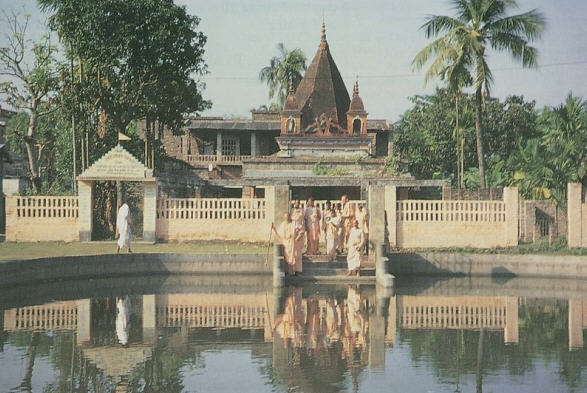
The rain has subsided. Early in the morning we tour Ambika Kalna.
First we visit the temple of Gauridasa Pandita and hear the story of how his large, beautiful Deities of Gaura-Nitai (Caitanya-Nityananda) once left the altar and joined a group of devotees chanting Hare Krsna. Gauridasa Pandita wanted Lord Caitanya and Nityananda Prabhu to stay in Kalna permanently. When the Lords told him that wasn't possible, he asked if They would allow him to make Deities of Them and thus always be present there in Their Deity forms. After the wooden Deities were completed, Gauridasa requested Lord Caitanya and Nityananda Prabhu to stay and let the Deities go instead. To prove that They and their Deity forms are identical, the Lords placed themselves on the altar, raised Their arms, and became wooden Deities. And the Deities walked away out the door of the temple. Gauridasa requested the mobile forms to remain, but They raised Their arms and became motionless Deities, and the Deities on the altar walked away. They repeated this a few times, until Gauridasa could no longer distinguish between his Lords and Their Deity forms.
Nearby we visit a temple of Radha-Syamasundara. Suryadasa Sarakela, the father-in-law of Lord Nityananda and elder brother of Gauridasa Pandita, worshiped these Deities. Next stop is the samadhi of Bhagavan Dasa Babaji, a friend of Jagannatha Dasa Babaji. When Bhagavan Dasa was too old to go to the Ganga, the Ganga came to him. Near his place of worship is a small stairway down to Patal Ganga, where he would bathe.
April 1
Buses take us to Adisaptagram to see the asrama and temple of Uddharana Datta Thakura, whose samadhi we visited a few days ago. According to the Caitanya-caritamrta, Uddharana Datta Thakura was born with the right to worship Lord Nityananda. Srila Prabhupada is in the family line of Uddharana Datta Thakura.
Lord Nityananda spent much time here. Once He stuck a wooden spoon into the ground here, and up popped a flowering tree, still flowering today.
Raghunatha Dasa Gosvami's birthplace, our next stop, is in a secluded spot next to the Sarasvati River, here just a stream. In the temple, we offer respects to his murti (carved form) and touch his shoes. His house is about a mile through the jungle from here.
Next we go to Sivananda Sena's temple, established by his son's disciple.
Our last stop is Caitanya-doba, at Halisahar. When the Lord visited this holy place and was told it was the birthplace of His spiritual master, Isvara Puri, the Lord declared, "This spot is worshipable for Me." He picked up a clod of dirt and wrapped it in His cloth. So many devotees followed the Lord's example and removed so much dirt that they dug out a hole approximately 60 feet by 150 feet, which then filled with water. Later a brick retaining wall was built around the lake.
April 2
This morning we go to the Annapurna temple, where one asks permission to enter the dhama, the holy land of Lord Caitanya's pastimes. Down the street is a Radha-Syamasundara temple established by Biracandra Prabhu, Lord Nityananda's son. Lord Nityananda lived here with his two wives: Jahnava and Vasudha, Biracandra's mother.
Jayapataka Swami tells us the story of the appearance of this very beautiful Deity. One night Biracandra had a dream in which Krsna came to him and said He would manifest Himself in stone. Biracandra should get that stone and make a Deity.
Later, Emperor Hussein Shah's son, who had heard of the power of Biracandra, sent for him.
"My daughter is very sick," the prince told Biracandra. "If you cure her, I'll give you whatever you want. If you don't, you're an impostor, and I'll kill you."
Biracandra cured the daughter. Then he asked the Shah's son for a stone from the palace wall.
The Shah's son protested, "But that stone is supporting everything. If you take it, the wall will collapse."
But finally he agreed. "Do whatever you want."
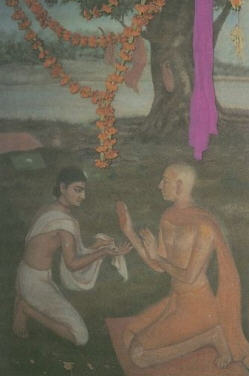
When Biracandra started a kirtana, the stone slid out and fell down, but nothing else moved. He wanted to take the stone to the Ganga, but no one could move it, even by using elephants. The devotees started chanting again, and then they were able to move the stone easily. Some people objected to bathing the stone in the Ganga, afraid it would sink, but when it was placed in the Ganga, it floated.
Biracandra gave the stone to a man to carve a Deity. The first Deity he carved was too big, the second one too small, and finally the third one fit the proportions of the Deity in Biracandra's dream. It is this third Deity we are now seeing as Radha-Syamasundara. The first Deity carved is Radha-Nanda-dulala, ten miles from here. The second Deity, Radha-Radhavallabha, is worshiped in a temple across the river.
From Radha-Syamasundara's temple we walk to Biracandra's birthplace (Lord Nityananda's residence) to offer respects to his murti and his Radha-Krsna Deities. The pujari there tells us Biracandra Prabhu took initiation from Jahnava, his stepmother. One day Jahnava was cooking, and her sari fell from her head. Biracandra saw that she manifested two more arms to catch her sari.
After crossing the Ganga, we take a riksha to a temple of Lord Jagannatha. This is the place of the associate of Lord Caitanya named Kamalakara Pippalai. Approaching the temple, we first notice the huge festival cart (ratha) sitting in the street. No one is worried it will be stolen, because it's made of solid iron and steel. It takes five hundred people to pull the cart on Rathayatra day.
We are all allowed inside the Deity room of Jagannatha, Baladeva, and Subhadra. The Deities are six hundred years old. Paintings on the walls of the kirtana hall depict the long story of Their appearance.
After our last stretch down the Ganga, we arrive at Panihati, where we disembark for the last time.
Jayapataka Swami tells us that Lord Caitanya resides wherever Lord Nityananda dances. Once while Lord Caitanya was in South India, Lord Nityananda danced here at Raghava Pandita's house. Lord Caitanya came to see, but only Lord Nityananda could see Him.
"He's here, and He's wearing a garland of flowers from South India," Nityananda Prabhu informed to his followers. "If you breathe deeply, you can smell it."
They did so and became ecstatic.
Lord Nityananda came here to Raghava Pandita's house regularly, as He lived nearby. The devotees had such ecstatic kirtanas they'd pull up palm trees and dance with them, they'd pick up bamboo rods and play them like flutes, and they'd perform other superhuman feats. Lord Nityananda pumped everyone full of transcendental ecstasy, and Bengal was flooded with kirtana.
We arrive back in Mayapur at 9:30 P.M., blissfully singing, "Ganga! Ganga!"
Mahamaya Devi Dasi was initiated by Srila Prabhupada in New York in 1971. She is a proofreader and the compiler of a database of Srila Prabhupada's disciples. She and her husband and 14-year-old son live most of the year in Mayapur and Vrndavana.
Ganga Safari Route
1. Burdwan (Barddhaman)
2. Kanai Natshala
3. Ramakeli
4. Ziya Ganj
5. Uddharanpur
6. Katwa (Katoya)
7. Srikhanda
8. Chakundi
9. Agradvipa
10. Pyari Ganga
11. Ambika Kalna (Kalna)
12. Adisaptagram
13. Halisahar
14. Kancharapara
15. Shrirampur
16. Panihati
Life on the Boat
OUR SAFARI has three boats, each with a crew of three or four and a guard. The women's boat holds twenty-eight, the family boat (ours) holds eighteen, and the men's boat holds the Deities, the kitchen, Jayapataka Swami, and countless brahmacaris.The boats have two levels: the deck (about ten feet above the water) and the downstairs cabin, where we sleep on thin mattresses on the floor or on the continuous benches along the sides of the boat. The motor is also downstairs, making conversation nearly impossible.
At the back of the cabin are two WCs and a metal bucket on a long rope, used for scooping up Ganga water. To avoid offending the Ganga, we replace the boats' toilets (holes over the water) with special toilets.
Up on deck we enjoy a beautiful view of the lush tropical scenery, especially from the roof of the captain's cabin. All along the route, villagers wave at us, and we wave back, yelling or chanting Hare Krsna.
Twice boats get stuck on sandbars hidden under the Ganga. One boat has to be towed, the other gets a hole in its side.
During a sudden rainstorm we go downstairs, only to learn that our boat is not waterproof. Water drips from the deck throughout the cabin. We move our luggage and blankets around in a vain attempt to keep them dry. The only dry area is under the captain's cabin, where, by Krsna's mercy, I've pitched my small tent, which doubles as mosquito netting. Two young children curl up in dry bedding next to my tent.
After the rain we find the gangplank one-third in the water and covered with slippery mud.
As I return from a pilgrimage the next day, I am amazed to realize that, despite the inconveniences, nothing daunts my enthusiasm for living on the boat.
